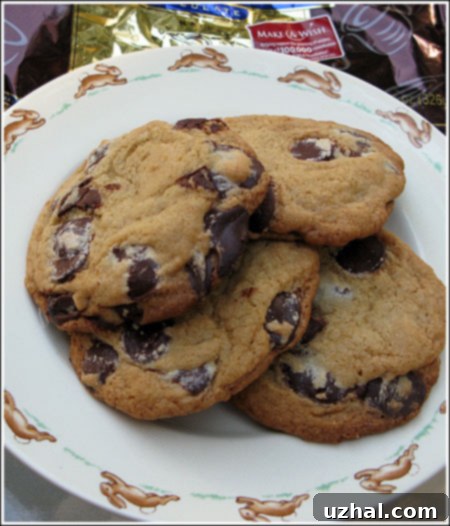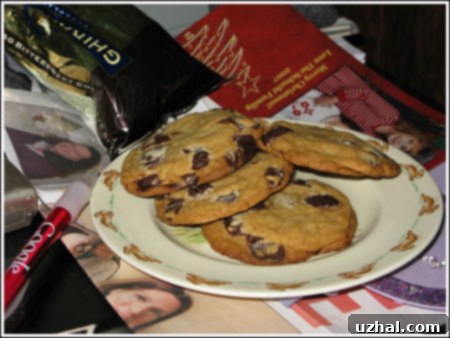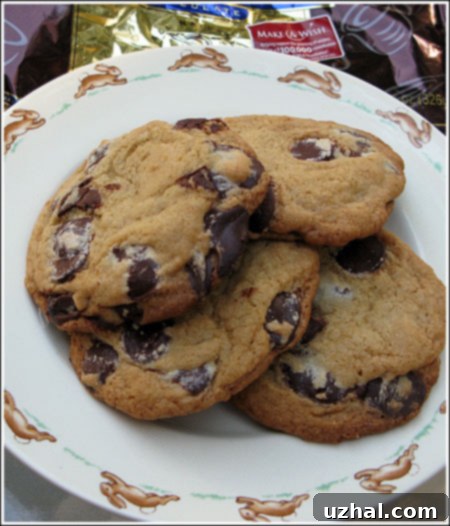Mastering Sherry Yard’s Large Chocolate Chip Cookies: A Guide to Thick, Dense Perfection
Every baker has a favorite chocolate chip cookie recipe, a true classic that stands the test of time. For me, that quest often leads back to the esteemed pastry chef Sherry Yard. This article delves into my adaptation of her famous Large Chocolate Chip Cookies recipe, originally found in her captivating book, Desserts by the Yard. Yard’s book is more than just a collection of recipes; it’s a delightful culinary journey, starting with nostalgic treats from her childhood in Brooklyn, evolving through her experiences as a burgeoning pastry student and chef, and culminating in her celebrated status as the “Pastry Queen of Beverly Hills.” While her repertoire boasts an array of intricate and innovative desserts, the enduring appeal of a perfectly executed chocolate chip cookie drew me in. And let me tell you, Yard’s approach to this beloved classic certainly did not disappoint. It’s a recipe that promises and delivers a truly exceptional cookie experience, known for its unique texture and rich flavor profile.

The Secret to Texture: The Pan Banging Method
What sets these Large Chocolate Chip Cookies apart is their signature texture: remarkably thick, wonderfully dense, and packed with an impressive amount of rich chocolate. One of the most fascinating and impactful techniques introduced by Sherry Yard in her recipe, and one that I encountered for the first time with her, is the “pan banging” method. This technique is specifically designed to create flatter cookies with uniquely crinkled edges and an irresistibly chewy, dense center. This isn’t just a quirky step in the baking process; it’s a deliberate and highly effective method that significantly influences the cookie’s final structure and texture.
The core concept of the pan banging method is both simple and ingenious: approximately halfway through the baking process, you gently but firmly tap the cookie sheet down on the inside of the oven door or another heat-proof, sturdy surface. This forceful yet controlled action causes the cookies to deflate slightly, expelling any trapped air and encouraging them to spread out rather than puff up. This process prompts the edges to set quickly while the center remains soft and pliable. By repeating this “banging” action a couple of times during the latter half of the baking cycle, you actively shape the cookie’s structure. It helps to create those characteristic ripples or crinkled edges that are highly sought after in gourmet chocolate chip cookies, and it contributes to a consistently denser texture throughout, preventing them from becoming overly airy or cakey. This method has since gained popularity among many bakers, but Sherry Yard was undoubtedly a pioneer in showcasing its effectiveness. The ultimate result is a cookie that boasts a satisfyingly chewy bite from edge to center, a direct benefit of the controlled spreading and purposeful deflating that the pan-banging technique facilitates. If you have ever been disappointed by cookies that are too cake-like or fail to achieve that perfect flat, crinkled, and dense profile, incorporating the pan-banging method will undoubtedly prove to be a transformative addition to your baking repertoire.

Ingredient Insights and Recipe Variations for Optimal Texture
My baking journey with Sherry Yard’s culinary wisdom extends across two of her highly regarded books: “The Secrets of Baking,” which was her debut publication, and “Desserts by the Yard,” her second, more autobiographical work, and the esteemed source of this particular chocolate chip cookie recipe. It’s fascinating to note that while both books feature recipes for chocolate chip cookies, there are subtle yet important distinctions in their ingredient ratios. For instance, the recipe in “The Secrets of Baking” specifies a slightly greater quantity of sugar – precisely ½ cup plus 2 tablespoons each of brown and granulated sugar. This totals a ¼ cup more sugar compared to the “Desserts by the Yard” recipe, which calls for a balanced ½ cup of each sugar type.
This variation in sugar content is not insignificant; it directly impacts the cookie’s final texture and how much it spreads during baking. Generally, a higher sugar concentration tends to yield a crispier cookie with a more pronounced spread, while a slightly reduced sugar amount can contribute to a softer, chewier texture with less spread. Recognizing these subtle differences empowers a baker to fine-tune the recipe to their personal preference. For these Large Chocolate Chip Cookies, the equitable ½ cup of brown sugar and ½ cup of granulated sugar, as detailed in “Desserts by the Yard,” achieves a superb balance. This ratio creates a cookie that is perfectly chewy in the middle with just the right amount of crispness at its edges, complementing their inherent thick and dense characteristics.
Beyond the sugar, another crucial element in my adaptation, and a deliberate modification from Yard’s original instructions in “Desserts by the Yard,” pertains to the preparation of the butter. While her recipe typically advises starting with softened butter, I have consistently achieved superior results by beginning with *cold butter*. The technique involves beating cold, unsalted butter, cut into chunks, with the sugars until it softens purely through the mechanical friction generated by the beaters. This method intentionally incorporates less air into the butter-sugar mixture at the initial stage of creaming. The reduced aeration is fundamental to developing a denser, more substantial cookie that retains its shape and thickness during baking, rather than spreading excessively thin. Although the initial mixture might appear somewhat lumpy and grainy, this is a normal and desired part of the process. As you continue to beat and then incorporate the vanilla extract and a large egg, the batter will gradually smooth out, resulting in a wonderfully rustic yet cohesive dough, perfectly primed before the dry ingredients are folded in. This meticulous approach to butter handling is a cornerstone for achieving the cookie’s signature thick and dense structure, ensuring the dough is robust enough to generously hold an abundant amount of rich chocolate without becoming light or cake-like.
The selection and quality of chocolate are equally paramount in this recipe. With a proud emphasis on a high proportion of chocolate, it’s clear that chocolate is intended to be a star ingredient. Opting for a premium bittersweet chocolate, whether in convenient chip form (such as a 12 oz bag of Ghirardelli bittersweet chocolate chips) or by carefully chopping a high-quality bittersweet chocolate bar, will profoundly elevate the overall flavor profile. This choice introduces a luxurious, deep cocoa note that beautifully contrasts and complements the sweet, rich cookie dough. The sheer quantity of chocolate specified ensures that each bite is not just a hint, but a full, gratifying experience of molten, gooey chocolate, making these cookies truly indulgent.
Furthermore, paying close attention to other details such as accurately weighing the flour (a practice that ensures consistent results, as flour density can significantly vary when measured by volume) and employing proper mixing techniques (particularly avoiding overmixing once the flour is added, which can lead to the development of gluten and consequently tougher cookies) are absolutely fundamental for achieving the desired textural outcome. Even the optional step of chilling the cookie dough, while not strictly required for baking, can significantly enhance the flavors by allowing them to meld and mature, and it helps to further reduce spread, contributing to that coveted thick, chewy cookie texture. These combined elements create a cookie that is a cut above the rest.
Related Baking Adventures
If you’ve enjoyed this in-depth exploration of classic cookie baking and are looking to expand your repertoire, you might also be interested in discovering some of our other cherished recipes and baking insights. These selections offer a variety of treats, from other delightful cookies to elegant cakes, all designed to inspire your next kitchen adventure:
- Blue Ribbon Fair Cookies: A Taste of Nostalgia
- Effortless Angel Food Cake Recipe: Light and Fluffy Perfection
- Decadent Cranberry Chocolate Fudge Cake: A Berry and Chocolate Delight!
- The Easiest One-Bowl Cookie: Quick and Delicious!
- Irresistible White Chocolate Chunk Macadamia Cookies: A Tropical Treat
Large Chocolate Chip Cookies Recipe

Large Chocolate Chip Cookies
Anna
Pin Recipe
Ingredients
- 1 ½ cups all purpose flour** (approx. 200 grams; weighing is recommended for accuracy and consistent cookie texture)
- ½ teaspoon baking soda (2.5 ml, crucial for leavening)
- ½ scant teaspoon salt (2.5 ml, enhances and balances sweetness)
- 1 stick cold butter, unsalted, cut into chunks (essential for achieving the unique dense texture of this adapted recipe)
- ½ cup brown sugar (100 grams, contributes to chewiness and moisture)
- ½ cup granulated sugar (100 grams, adds to crispness and aids in spreading)
- 1 teaspoon vanilla extract (5 ml, for rich aromatic flavor)
- 1 large egg (binds the ingredients and adds moisture)
- 1 12 oz bag Ghirardelli bittersweet chocolate chips or 12 ounces of chopped bittersweet chocolate (use high-quality chocolate for superior flavor)
Instructions
-
Preheat your oven to 350 degrees F (175 degrees C). Ensure the oven is fully preheated before placing cookies inside for even baking.
-
In a medium bowl, accurately weigh your all-purpose flour. Add the baking soda and salt to the flour, and whisk or stir them together thoroughly to ensure all dry ingredients are evenly distributed. This step is critical for consistent leavening and flavor.
-
Cut the cold stick of unsalted butter into tablespoon-sized chunks. For a slight ease in beating, you can microwave it very briefly for about 10 seconds. The butter should remain cold and firm, not soft or melted. If using a powerful stand mixer, you may skip this microwave step entirely, as the mixer’s paddle attachment will soften the cold butter through friction alone.
-
In a large mixing bowl or the bowl of a stand mixer fitted with a paddle attachment, combine the cold butter chunks with both the brown sugar and granulated sugar. Begin beating the butter and sugar on medium speed. The primary goal here is to gradually soften the butter through the friction of the beaters and the abrasive action of the sugar granules. Initially, the mixture will appear quite lumpy and grainy, with the sugar adhering to the butter in a rough, uneven texture. Continue beating until the mixture starts to come together and smooth out slightly, though it will not become light and creamy as with softened butter. Next, beat in the vanilla extract, ensuring it is well incorporated. Finally, add the large egg and beat for approximately 30 seconds until the egg is fully integrated and the mixture forms a cohesive, albeit still somewhat rough, batter.
-
Using either a sturdy spatula for hand-mixing or the lowest speed on your stand mixer, gradually incorporate the prepared flour mixture into the wet ingredients. Mix until the flour is just combined and no streaks remain. It is crucial to avoid overmixing at this stage, as excessive agitation can develop the gluten in the flour, leading to tougher cookies. Once the flour is incorporated, gently fold in the generous quantity of chocolate chips (or chopped bittersweet chocolate). This recipe intentionally features a high proportion of chocolate, guaranteeing a rich and intensely chocolatey experience in every single bite.
-
At this point, you have the option to chill the cookie dough. While not strictly mandatory for baking, chilling the dough for at least 30 minutes (or even overnight) can significantly enhance the flavors, allowing them to deepen, and helps to reduce spread, contributing to an even thicker and chewier cookie. Once ready, scoop the dough using very generous tablespoons, forming substantial mounds. Arrange these dough mounds onto an ungreased cookie sheet, ensuring they are spaced at least 3 inches apart to allow ample room for spreading during the baking process.
-
Bake one sheet of cookies at a time on the center rack of your preheated oven for 13-15 minutes. Halfway through the baking time (typically around 7-8 minutes), rotate the cookie sheet 180 degrees to ensure even baking and browning. This is also the ideal moment to implement the unique “pan banging” technique: carefully but firmly lift the cookie sheet and tap it down onto the oven rack or the inside of the oven door. This action will cause the cookies to deflate slightly, which is precisely what creates those characteristic crinkled edges and contributes to a denser, chewier interior. Repeat this gentle bang once more approximately 3 minutes before the estimated end of baking if you desire a more pronounced crinkle. The cookies should emerge from the oven with beautifully golden-brown edges, appearing set but still slightly soft and pliable in their centers.
-
Once baked, allow the cookies to cool undisturbed on the hot cookie sheet for about 3 minutes. This crucial resting period permits them to set up further and become firm enough to prevent breaking when transferred. After 3 minutes, carefully transfer the warm cookies to a wire rack to cool completely. The exact yield of the recipe can vary slightly depending on the size of your scoops; for maximum freshness, I often bake a portion of the dough and store the remainder in the refrigerator or freezer for future batches of freshly baked cookies.
Notes
Why These Large Chocolate Chip Cookies Stand Out
In a culinary landscape saturated with countless chocolate chip cookie recipes, Sherry Yard’s rendition, particularly with the subtle yet impactful modifications detailed within this article, genuinely distinguishes itself. The thoughtful combination of the unique cold butter method during creaming and the innovative pan-banging technique during baking culminates in a cookie that masterfully avoids the common pitfalls of being either too flat and overly crispy or too puffy and undesirably cakey. Instead, what you achieve is a true masterpiece of texture: a deeply satisfying chewiness that permeates the entire center, perfectly golden and set edges, and that alluring crinkled appearance that subtly hints at the rich layers of flavor and intricate texture within.
Beyond the ingenious techniques employed, the careful balance of sugars – specifically, the brown sugar contributing its signature moisture and depth of flavor, complemented by the granulated sugar lending that delicate crispness – ensures a harmonious sweetness. This precise balance allows the high-quality bittersweet chocolate, chosen for its superior flavor profile, to truly shine through as the star ingredient. Each generously portioned scoop of dough transforms in the heat of the oven into a substantial, truly impressive cookie that manages to feel both elegantly gourmet and profoundly comforting all at once. Whether you consider yourself a seasoned baking enthusiast or are just embarking on your journey into the art of home baking, this particular recipe offers a remarkable opportunity to elevate a universally beloved classic into something truly extraordinary. It transcends the definition of merely “a cookie”; it delivers a sensory experience in every single bite, serving as a testament to thoughtful, precise baking and the unwavering pursuit of perfection, even in seemingly simple culinary creations.
We wholeheartedly encourage you to give these large chocolate chip cookies a try. Embrace the exciting and effective pan-banging method, and discover for yourself a new favorite recipe that we are confident will swiftly become a cherished staple in your personal baking repertoire. After you’ve baked and savored these magnificent treats, don’t forget to share your experience, any personal tips you uncover, and your thoughts in the comments section below! Your feedback is invaluable and helps our baking community grow.
